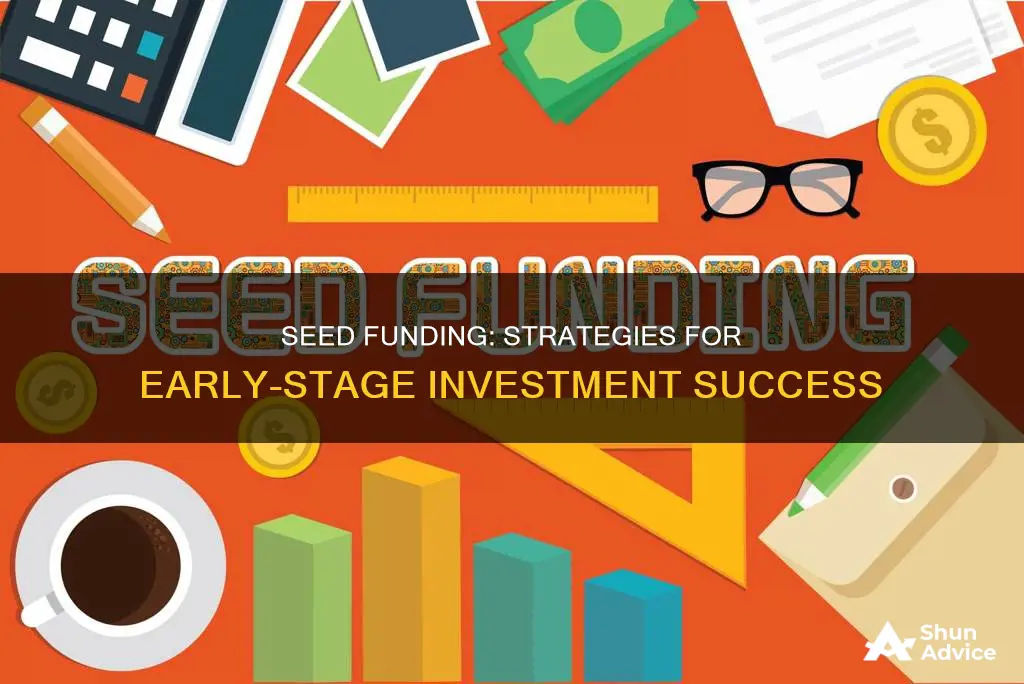
Seed funding is the first official funding round for a startup, providing the initial sums of capital needed to get the business up and running. It is often the first investment made in a new company, and is used to cover the initial stages of product development, market research, and other early-stage operations. This type of funding can come from various sources, including angel investors, friends and family, personal funds, crowdfunding, and accelerators or incubators. When seeking seed funding, it is important for entrepreneurs to have a clear understanding of their financial needs and how they plan to spend the investment. This article will explore the process of securing seed funding, the different sources of capital, and the key considerations for entrepreneurs looking to take their business to the next level.
| Characteristics | Values |
|---|---|
| Definition | Seed money is part of the early-stage investments startup companies receive from investors in exchange for an equity stake in the company. |
| Purpose | To get the business up and running, cover initial stages of product development, extensive market research, and other initial-stage operations. |
| Sources | Angel investors, friends and family, personal accounts, crowdfunding, accelerators and incubators. |
| Investor Expectations | Equity, stake percentage, or share of later-stage profits. |
| Investor Type | Angel investors are individuals who invest their own money, expecting a larger equity percentage. |
| Amount | Depending on the nature of the startup, the seed capital can be a small or large amount. Enough seed capital should be raised to reach the needed metrics for the next funding round. |
| Timing | When company founders are ready to tell their story and have enough evidence to show they have a strong product, market, or team. |
| Funding Rules | Comply with SEC requirements, avoid giving up too much company stake (>25%), be realistic about the amount, have supporting research and data, be transparent about financials. |
What You'll Learn

Understanding seed funding
Seed funding is the first official funding round for a startup, coming after pre-seed investments. It is an early-stage investment that helps get a business up and running. It covers the initial stages of product development, market research, and other foundational operations. The funds are used to fuel the growth of the business.
Seed funding is crucial for startups as it provides the initial capital needed to develop their operations. In exchange, investors receive an ownership percentage of the business, usually between 10-25%. This "giving away" of ownership brings new management insights and can offer competitive advantages to the startup. The deal is mutually beneficial, as the investor receives a percentage of future profits.
The amount of seed funding required depends on the nature of the business and investor expectations. Generally, enough capital should be raised to reach the metrics needed for Series A funding. This amount should be comfortably raised within 12-18 months.
There are various sources of seed funding:
- Angel investors: Accredited, high-net-worth individuals who invest in startups to diversify their portfolios. They tend to value intangibles, such as the product idea and management team, as most startups lack a proven track record.
- Friends and family: They may loan money to the startup but expect repayment.
- Personal funds: Entrepreneurs can use their own money to invest in their venture.
- Crowdfunding: Platforms like Kickstarter allow startups to raise seed capital from a large number of people.
- Accelerators and Incubators: These are alternative options that provide capital and support to startups for fixed terms or undetermined periods, respectively.
Seed funding is essential for startups to gain a solid financial footing and develop their business. It is the first step in the funding process, providing the initial boost to attract further investment and grow the company.
Invest Like Mohnish Pabrai: Fund Strategies and Secrets
You may want to see also

How much capital to raise
The amount of capital to raise in seed funding depends on several factors, including the nature of the company, the initial costs of developing the business idea, and the personal connections of the founders. Seed funding is typically a relatively modest sum of money, as it comes from personal sources such as family, friends, and other acquaintances of the founders.
Seed funding is generally used to cover the essentials a startup needs, such as a business plan, rent, equipment, payroll, insurance, and research and development costs. It is important to keep in mind that the primary goal at this stage is to attract more financing from venture capitalists or banks, so the amount raised should be enough to develop a compelling proposal.
Some companies, like Seedcamp, are first-cheque investors, backing founders with investment amounts between $350K and $1M. However, the amount of seed funding a company receives can vary greatly. For example, Death & Co raised over $6,000,000 in seed funding, while KnightScope raised $15,000,000.
It is worth noting that seed funding is just the first of four funding stages required for a startup to become an established business. The subsequent stages are venture capital, mezzanine funding, and an initial public offering (IPO). Therefore, the amount of capital raised in seed funding should be balanced with the understanding that there will be additional opportunities to secure funding in the future.
Invest Wisely: Strategies for Fidelity Funds
You may want to see also

Different types of seed investors
Seed funding is a very early investment in a startup, meant to support the business until it can generate cash on its own or until it is ready for further investments. There are several types of seed investors:
Friends and Family Funding
This type of seed funding involves raising money from friends and family members. This is often the first port of call for new businesses as it is money from personal sources and is usually a modest sum.
Angel Investors
Angel investors are wealthy individuals who provide seed funding in exchange for equity ownership. They are generally high-net-worth individuals (HNWI) and may come from the personal network of a startup's founder(s). They often enjoy a hands-on role in helping develop a company from scratch.
Seed Accelerators
These are programs that provide startups with seed funding, mentorship, and resources to help them grow their businesses. They can be a great way for new businesses to get support and guidance as they navigate the early stages of their development.
Crowdfunding
This type of funding allows startups to raise money from a large number of people, typically through an online platform. It can be a way to validate a product idea and build a customer base without equity dilution, as the crowdfunded capital is not tied to share or equity offerings.
Incubators
Incubators are organizations that provide startups with seed funding, office space, and other resources to help them grow their businesses. They can be a great option for startups that need more than just financial support to get off the ground.
Government Grants
Some government agencies provide seed funding for startups working on specific projects or in certain industries. These programs can be targeted towards youth or adolescent self-employment and are often tied to political initiatives.
Corporate Ventures
Some large companies set up venture arms to provide seed funding to startups in their industry or a complementary field. This type of investment may come with more expertise and resources than traditional private equity offerings.
Crowdfunding Real Estate: Getting Investors for Your Property Empire
You may want to see also

How to approach seed investors
Approaching seed investors is not an easy process. While finding investors may be simple, pitching your idea to them is challenging. There are several types of seed investors, each with its own unique approach. Here are some tips on how to approach seed investors effectively:
Friends and Family
The first type of seed investment often comes from friends and family. This method is usually the fastest way to secure funds, but it has limited capacity and may not offer much potential for further investment. Friends and family investors are based on emotional trust rather than a thorough analysis of the offering. Therefore, approaching them should be a last resort, if at all. Keep in mind that failing to raise money from other types of investors may hinder your ability to approach friends and family in the future when larger amounts are needed.
Angel Investors
The second type of seed investor includes individuals with industry knowledge and experience. These investors, known as angels, typically have a portfolio of companies they have invested in. They are diverse in the amount of money they can invest and may participate in larger investment rounds when needed. Angel investors often invest together, allowing them to bring larger amounts of capital while mitigating risks. Additionally, they usually have strong networks that can assist your venture in its early stages by connecting you with potential customers and valuable marketing channels.
Venture Capital Funds
Venture capital funds are another source of seed investment, but most of them will not invest in early-stage seeds. Only a minority will provide initial investments or loans. This option is valuable because it also assists in bringing the venture to market. However, obtaining investment from a venture capital fund can be a more time-consuming process and will likely involve more terms and conditions.
Incubators and Accelerators
The fourth type of seed investor includes various incubators and accelerators, each with its own unique model for distributing funds. Incubators and accelerators offer more than just money; they provide the infrastructure and resources needed for a new venture to grow. In exchange, they typically take a larger share of the holdings in the new company.
Preparing to Approach Seed Investors
- Research the potential investor's professional background to understand how it correlates with your venture.
- Gather information about their previous investments.
- Understand how the investor can help beyond just providing financial support.
- Assess their ability to invest in future rounds, rather than just a one-time initial seed investment.
Developing Your Pitch
When preparing your pitch for seed investors, consider the following:
- Emphasize the team behind the idea. Put the same effort into showcasing your team as you do in explaining the idea and its potential success.
- Have a solid business plan. Show that you are conservative in your use of investment funds and know how to maximize the value of their investment.
- Ensure you pitch the idea within the initial part of the meeting, leaving enough time for further discussion and addressing their questions and insights.
- Make a good impression and gain their trust. Cultivate an atmosphere of empathy and understanding.
- Be responsive to the investor's body language and inputs, providing additional details only when necessary.
Post-Meeting Follow-up
After the meeting, keep the following in mind:
- Don't get discouraged by negative feedback. Not everyone will share your enthusiasm for your idea, and that's okay. Each investor has their own preferences and unique point of view.
- Have a good lawyer by your side to review the valuations and terms of engagement to ensure you don't agree to anything you may regret later.
Emergency Fund Strategies: Where to Invest for Peace of Mind
You may want to see also

Rules to follow when seeking seed funding
- Understand the basics of seed funding: Seed funding is the first official funding round for a startup, coming after pre-seed investments. It is required to get the business up and running, covering initial product development, market research, and other operations.
- Know your funding sources: Seed funding can come from angel investors, friends and family, personal funds, crowdfunding, or accelerators and incubators. Each source has its own expectations and requirements.
- Have a clear business plan: Investors want to see a detailed plan for how their money will be spent. They will be more likely to invest if you can demonstrate a firm grasp of your financials and how much money you need to launch your business.
- Ask for enough capital: A common mistake is not asking for enough funding initially. While it may seem conservative to request a smaller amount, running out of money too quickly can be detrimental, as investors are often reluctant to invest more to keep a business afloat.
- Minimize the number of outside investors: Having too many investors can cause equity dilution, reducing the profitability of each equity stake. It can also be time-consuming to manage relationships with numerous investors, taking time away from running your business.
- Be aware of SEC requirements: Ensure you are compliant with the relevant regulatory requirements, such as those set by the SEC (or equivalent organizations in other countries).
- Maintain control of your company: Be cautious about giving up too much stake in your company during the seed round, as you will need equity left for later investment rounds. Keep in mind how much control you want to maintain and be realistic about your company's valuation.
- Be transparent: Provide clear and honest details about your current financial status and funding needs.
- Act swiftly: Once you have interested investors, work quickly to close the agreement.
Dave Ramsey's Investment Strategy: Specific Fund Choices
You may want to see also
Frequently asked questions
Seed funding is the first official funding round that follows pre-seed investments. It is the first round of funding a company goes through to make the company look attractive enough to secure more funding in the future. Seed funding is part of the initial investments made in new companies to get the business up and running.
Seed funding refers to the initial sums of capital a startup raises. The multiple funding rounds startups go through are set up to gradually build the company from a proposed model into a fully operational business. The seed investment round is often raised in cash to allow startups to live and grow, and a war chest is almost always a competitive advantage. The deal made between investors and the startup is mutually beneficial. The startup receives seed capital to develop its operations, and the investor receives an ownership percentage.
First, determine the right time to start collecting seed money. Then, decide on the funding type and the funding amount. Once you have identified your ideal investor type and established how much capital you need, start reaching out. Keep in mind that investors need to see evidence of future success and feel confident in making an investment.







